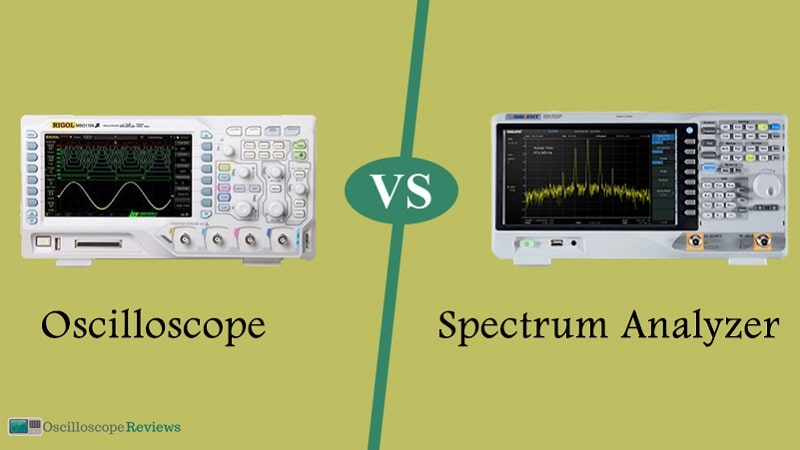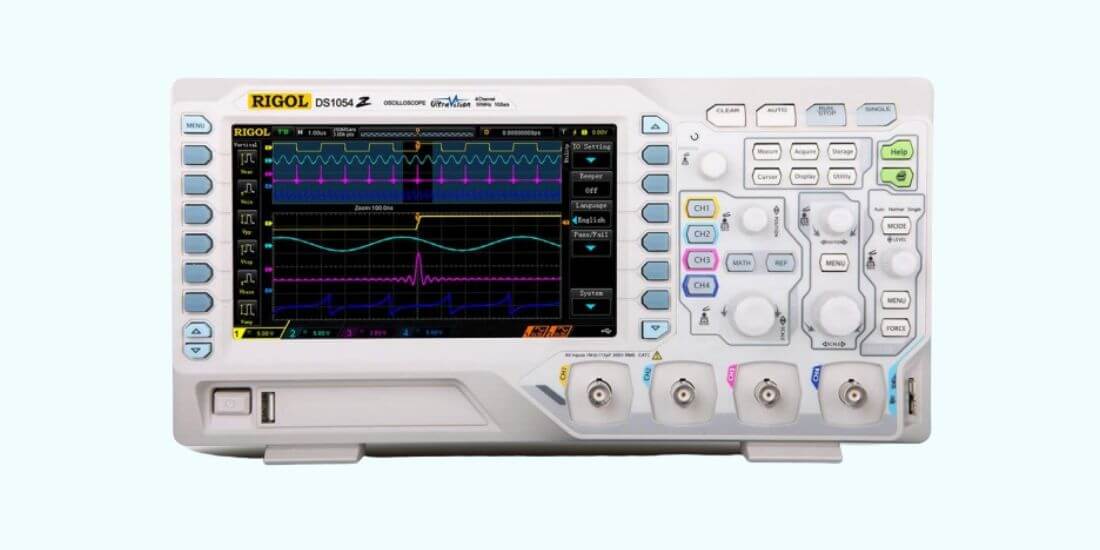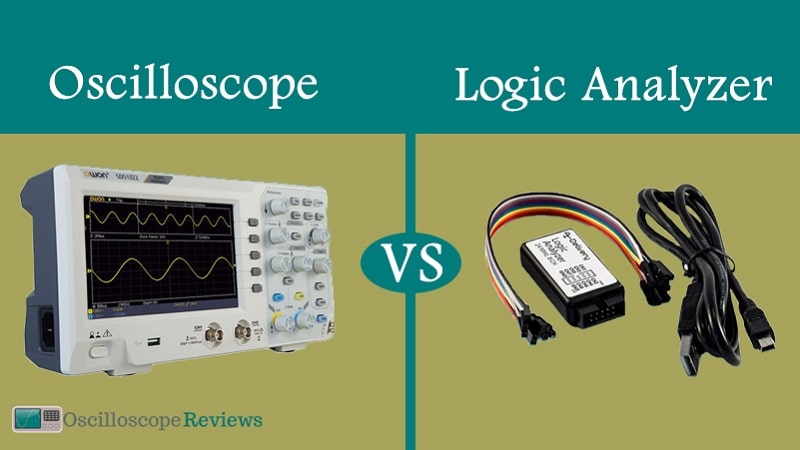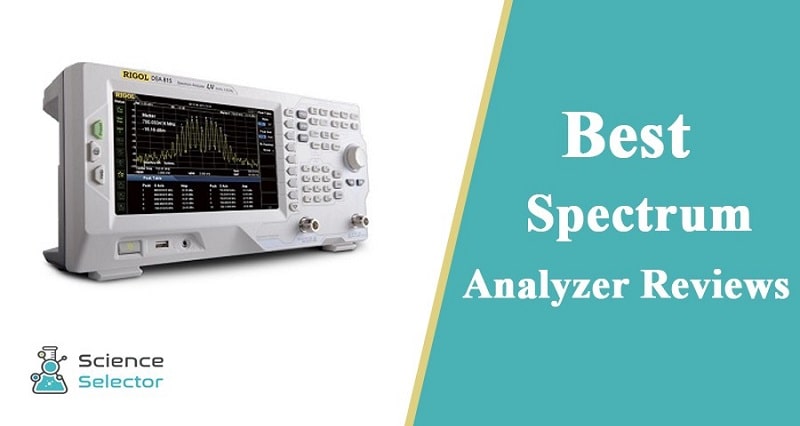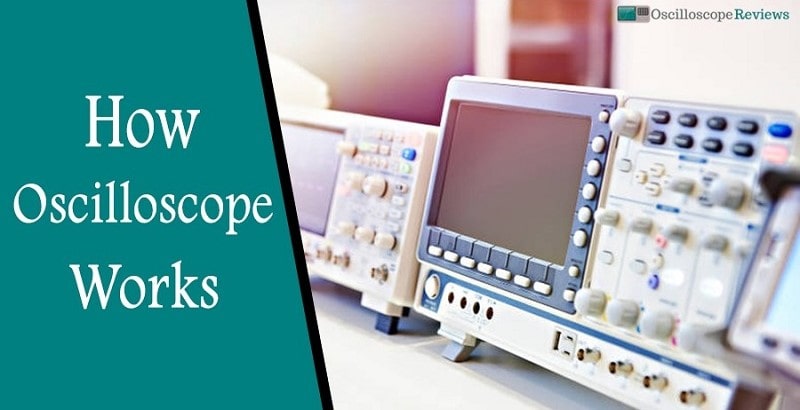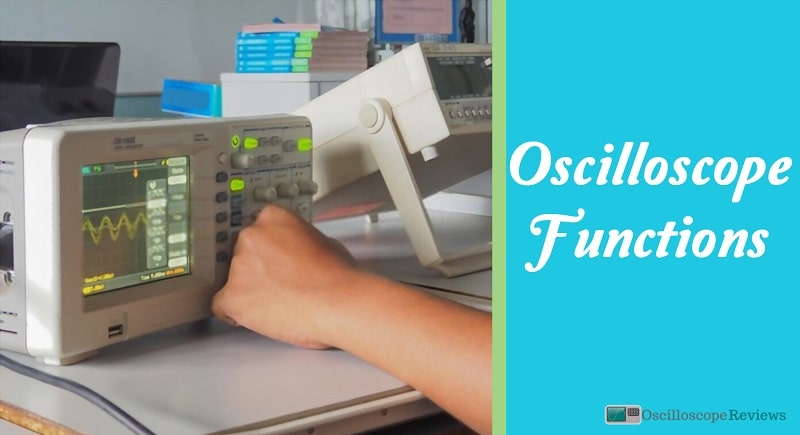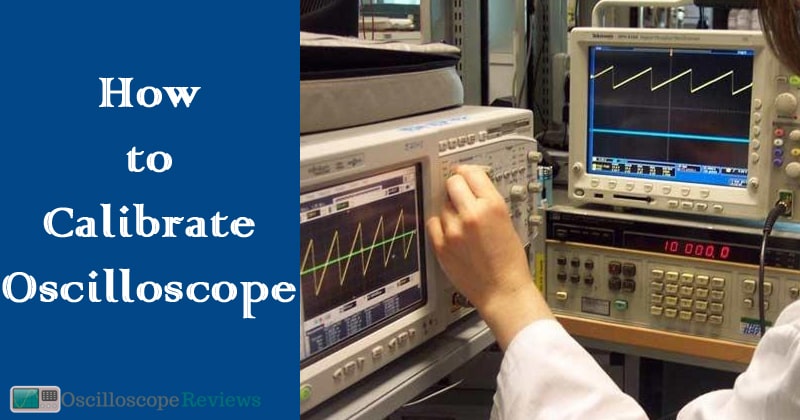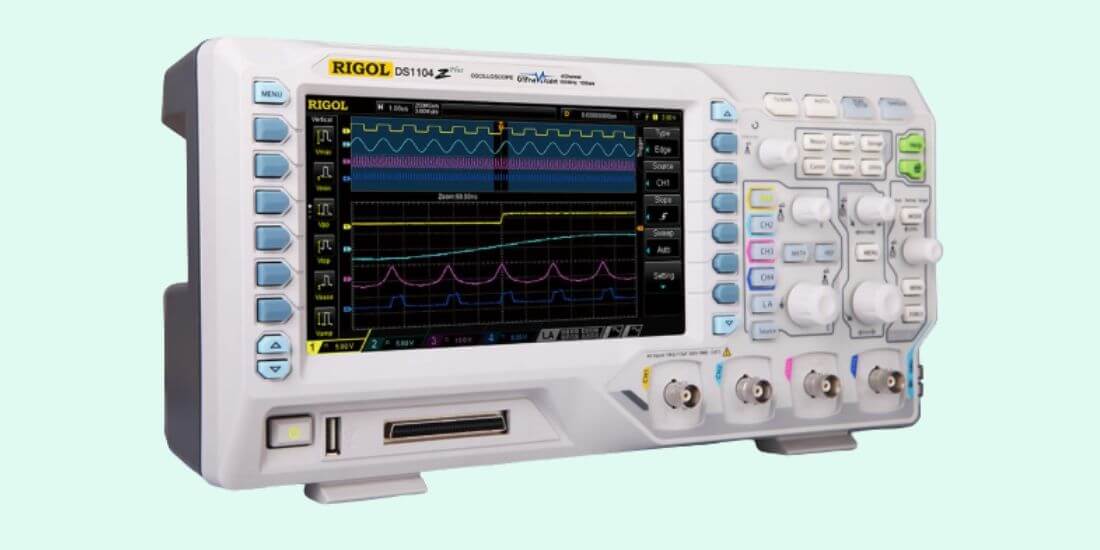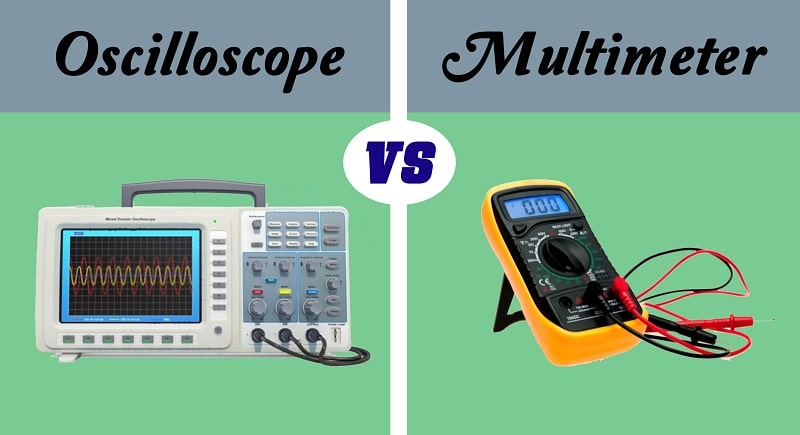The primary difference between these two instruments is that with an oscilloscope, you can see the signal using the time domain; the signal changes with respect to time. However, with an FFT spectrum analyzer, you can only view the signals using the frequency domain; how the signal changes in relation to changing frequencies.
Therefore, the oscilloscope sees the amplitude vs. time of a signal while a spectrum analyzer views the amplitude vs. frequency signals. This mode of operation is the chief difference of oscilloscope vs. spectrum analyzer. However, there are more distinctions worth looking at; read on!
An overview of oscilloscope & spectrum analyzer
For many years, RF engineers had a simple rule; measurements that needed frequency domain (band power, output frequency, signal bandwidth, etc.) were checked using a spectrum analyzer. Measures to do with the time domain, on the other hand, needed an oscilloscope. However, technology came in and turned around the signal processing techniques. Now, the difference that this equipment is capable of doing is relatively small.
Oscilloscopes incorporated the Fast Transform (FFT) technology that enables them to convert time-domain signals to their frequency domain. On the other hand, Spectrum analyzers capture data in the time domain and generate displays using post-processing technology.
However, even with these advancements, you can still notice some clear distinctions between the two platforms.
For instance, oscilloscopes had a limit in terms of their sample speed. This tool could detect signals up to DC but with very little GHz. Spectrum analysis could detect high signals into the microwave range. However, they cannot see transient signals while sweeping.
ER, radar, and communications technology keep advancing since these test equipment demands have become greater. With more technologies have been incorporated in the RF and microwave equipment, these technologies have increased the performance of these test equipment. Oscilloscopes and spectrum analyzers can achieve so much more than they could years back as their capabilities have widened and the distinctions between them have become so tiny.
Technology Advancement
Changes in technology have altered the way oscilloscopes and spectrum analyzers work.
Spectrum analyzers
A good number of today’s spectrum analyzers incorporate an all-digital signal processing (DSP) part. When using this oscilloscope, the incoming signal gets down-converted to a lower Intermediate Frequency (IF). The signal gets tested and digitized by the Analog-to-Digital Converter (ADC), which is processed by the DSP methods.
The new spectrum analyzer now uses two different modes in its operation; it uses the sweeping LO to view signals in a wide range or “pause” the LO to view everything within the analysis bandwidth.
This technology comes with several advantages, such as reliability and accuracy, since digital processing techniques have replaced the unreliable analog components. The improvement has also enabled the equipment to implement digital Resolution Bandwidth (RBW) log amplifiers and filters. The results have become more accurate.
Moreover, “pausing” the local oscillator allows you to collect data in one frequency. This technology makes it able to look at a wideband signal using the time domain. Since the signal can now be digitized, it can be shown in the time domain, just like the oscilloscope. However, the main difference is that the data in the spectrum analyzer is down-converted, so the data on display depends on the measurement of the center frequency.
The other difference is caused by the DSP that may demodulate and analyze signals like radar chirps and communication signals. This signal analyzer technique has a limit when it comes to the sampling speed of the ADC in the section of digital IF that confined the bandwidth to only have a few hundred MHZ.
Oscilloscopes
Modern digital oscilloscopes come in three categories; digital phosphor oscilloscopes (DPO), digital sampling oscilloscopes (DSO), and sampling oscilloscopes. All oscilloscopes have horizontal, vertical, triggering systems, and acquisition.
The vertical system is where the signals coming from the probe enter the system. At this point, the vertical system enhances the amplitude of the signal bringing it to a voltage range that matched that of the subsequent circuits, which is the analog-to-digital converter (ADC). The vertical system ensures that it does not change any other aspect of the signal except the deliberate amplitude and equalizing adjustments.
The acquisition system incorporates horizontal (timebase) features and digitizing and storage components. The acquisition system samples the voltage of the signals while collecting numerous data areas that it will display. A digital oscilloscope has a sampling clock located in the horizontal system. The sampling cock leads to the functioning of the analog-to-digital converter (ADC). The output from the ADC is put in the acquisition memory. The amount of the stored memory is referred to as the record length.
The trigger system perceives conditions that the user specifies during the incoming signal input. It applies the requirements as a time reference in the record of the wavelength. The oscilloscope then displays the event that intersected with the trigger. The display also shows the waveform record that followed the event. In both cases, you can observe the trigger event’s position in time.
The trigger system makes sure that the screen displays a stable and consistent waveform.
The trigger system searches for pulse widths, logic combinations, and voltage thresholds, and several other conditions that enable the date to qualify for acquisition.
Several aspects can limit the effectiveness of this architecture.
One aspect is the sudden large quantity of data that results from this fast sampling. This machine generates hundreds of gigabytes of data per second. While doing this, only a tiny fraction of a second can be captured and analyzed at ago when using the full bandwidth. Although data processing techniques like segmented memory can prolong the capture seconds, this technique only applies to repeated or pulsed signals.
The amount of resolution that it offers is another aspect that limits the effectiveness of an oscilloscope. High-speed ADCs can only provide 8 bits resolution, unlike signal analyzers that display 14 to 16 bits. If you need low-level signals from a wide frequency range, it is better to use a spectrum analyzer. However, for most radar applications and communications, the difference between the oscilloscope and the spectrum analyzer is not significant.
What are the differences between the two?
Although these two technologies have some similarities, they also have some distinct differences.
| Features | Typical Oscilloscope Specification | Typical Spectrum Analyzer Specification |
| Input Frequency Range | DC to 3.5 GHz | 9kHz to 3 GHz |
| Spurious Response | -45 dBc nominal | -60 dBc typical |
| Residual Response | -70 dBm | -90 dBm |
| Displayed average Noise | N/A | -150 dBm/Hz typical (10 MHz – 1.5GHz) -147 dBm/Hz typical (1.5 GHz-2.2 GHz) -143 dBm/Hz typical (2.2 GHz- 3GHz) |
1. Signal bandwidth and carrier frequency
The primary parameter that you need to consider when choosing between an oscilloscope and a spectrum analyzer is the bandwidth level of the signal you need to analyze. If the signal is within the spectrum analyzer’s bandwidth and the carrier frequency is higher than some few GHz, then the spectrum analyzer will be an ideal option. The lower sample rate of the spectrum analyzer will enable you to capture and analyze the data for a prolonged time.
Furthermore, a spectrum analyzer is less costly than an oscilloscope that has 10GHz frequencies and more. However, if the signals you want to analyze are more bandwidths that exceed a few hundred MHz, or if you wish to see the rise and falls that are below 20ns, then you better go for the oscilloscope.
2. Noise floor and Voltage Resolution
Data resolution also gives a notable difference between the two boxes. Standard spectrum analyzers are 14bits devices for sampling data. On the contrary, typical oscilloscopes sample their data at 8 bits. Unlike spectrum analyzers, an oscilloscope does not need filtering since it has a wide-open front end.
With the wide-open front, the oscilloscope has a lot of broadband noise that affects the measurement. This disadvantage will be more prevalent in environments that have high noise levels or many background signals. Data processing techniques that come with many applications can, however, minimize or erase this difference.
3. The number of data channels
A spectrum analyzer has only one channel. On the other hand, oscilloscopes have two or four channels. Although you can connect spectrum analyzers, be sure that it will cost you some bucks. Therefore, for measurements with two, three, to four channels, an oscilloscope has an unbeatable advantage.
To understand better the effects of these differences, below are some of the pros and cons of oscilloscopes and spectrum analyzers for various signals:
- Frequency-hopping signals
If the signal hops within the analysis bandwidth of the signal analyzer, data that has no gaps can be acquired for some seconds (or even for several minutes or hours when using an external RAID array). For high-speed oscilloscopes, the data can only be acquired for several milliseconds.
Should the frequency range of the hopping signal be wider, you will have to use an oscilloscope to make your work possible. A spectrum analyzer will not perform such tasks because the frequency range is way above its capabilities.
- Radar signals
Usually, radar signals often have relatively low bandwidths but have high carrier frequencies. When the bandwidth fits within the spectrum analyzer’s bandwidth analysis, it becomes the better option. The signal analyzer will give you a high resolution with prolonged capture duration for a lower amount of money.
However, if your sample has wider radar signals, you will need an oscilloscope so that you can view the entire signal once without having to sweep.
- Wideband and communication signals
A fast-speed oscilloscope is an excellent tool for demodulation and analysis of communication signals with higher than 100 MHZ symbol rates. Ku and Ka bands measurement signals that have symbol rates with several GHz are the most common.
- Small signal searching
If you want to end up with better results for low power signals like spurs, you must minimize the amount of noise during the measurement. The signal analyzer is capable of performing a narrowband sweep on a wide range of frequencies. Therefore, this machine can filter out a large amount of broadband noise, making it ideal for small signal searches.
- Multi-channeled signals
Applications like MIMO communications, Multiple Antenna Detection systems, and Phased Array Radar might be better if analyzed and compared in more than one signal in parallel. In this analysis, the oscilloscope has a better advantage since it a four-channel device and the channels are time-coherent.
However, when working with more than four channels, we should look at both the technologies we have been talking about and work with several digitizers. Since the spectrum analyzers and oscilloscopes lack overhead and additional apparatus, digitizers can be a cost-effective solution for analyzing multiple channels. The only advantage is that you will need to add in more labor to configure and process data.
Conclusion
Due to the incorporation of digital signal processing techniques in the oscilloscopes and in spectrum analyzers, the differences that distinguish the two have become less significant because, in some instances, the oscilloscope can play the role of the best spectrum analyzer. In contrast, the spectrum analyzer can be the best fit for a position that the best oscilloscope would have done. Either way, the user will realize that current-day instruments have far more capabilities and features than those that existed decades ago.

